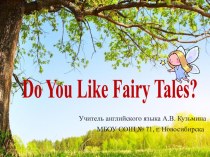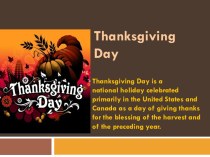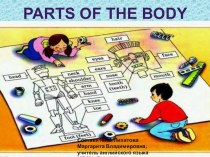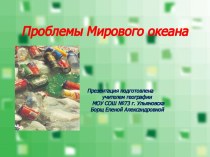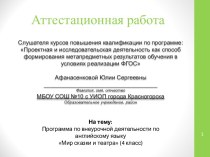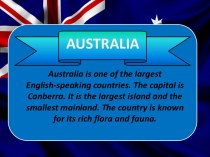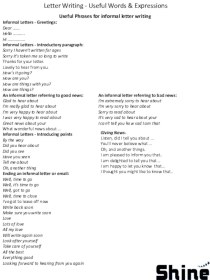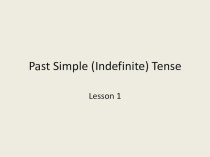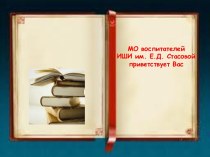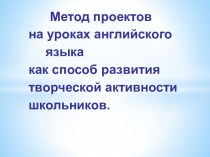- Главная
- Разное
- Бизнес и предпринимательство
- Образование
- Развлечения
- Государство
- Спорт
- Графика
- Культурология
- Еда и кулинария
- Лингвистика
- Религиоведение
- Черчение
- Физкультура
- ИЗО
- Психология
- Социология
- Английский язык
- Астрономия
- Алгебра
- Биология
- География
- Геометрия
- Детские презентации
- Информатика
- История
- Литература
- Маркетинг
- Математика
- Медицина
- Менеджмент
- Музыка
- МХК
- Немецкий язык
- ОБЖ
- Обществознание
- Окружающий мир
- Педагогика
- Русский язык
- Технология
- Физика
- Философия
- Химия
- Шаблоны, картинки для презентаций
- Экология
- Экономика
- Юриспруденция
Что такое findslide.org?
FindSlide.org - это сайт презентаций, докладов, шаблонов в формате PowerPoint.
Обратная связь
Email: Нажмите что бы посмотреть
Презентация на тему Деньги
Содержание
- 2. Modern moneyModern money (and most ancient money)
- 3. The emergence of moneyThe SumerianThe Sumerian civilization
- 4. Commodity moneyBartering has several problems, most notably
- 5. Standardized coinageFrom early times, metals, where available,
- 6. Using such a system still required several
- 7. Trade bills of exchangeBills of exchange became
- 8. TalliesThe acceptance of symbolic forms of money
- 9. Goldsmith bankersThe highly successful ancient grain bank
- 10. Demand deposits The primary business of the
- 11. BanknotesThe history of money and banking are
- 12. Paper banknotesMost banknotes are made from cotton
- 13. A World Without MoneyMoney, in some form, has
- 14. Скачать презентацию
- 15. Похожие презентации
Modern moneyModern money (and most ancient money) is essentially a token — in other words, an abstraction. Paper currencyModern money (and most ancient money) is essentially a token — in other words, an abstraction. Paper currency
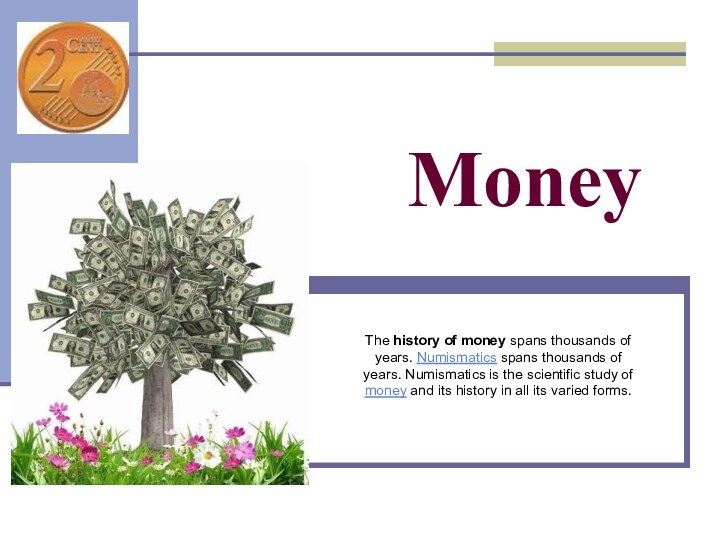
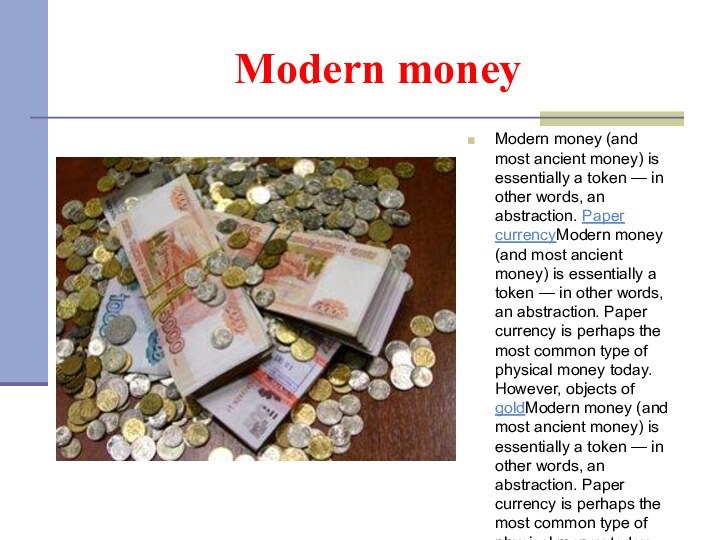



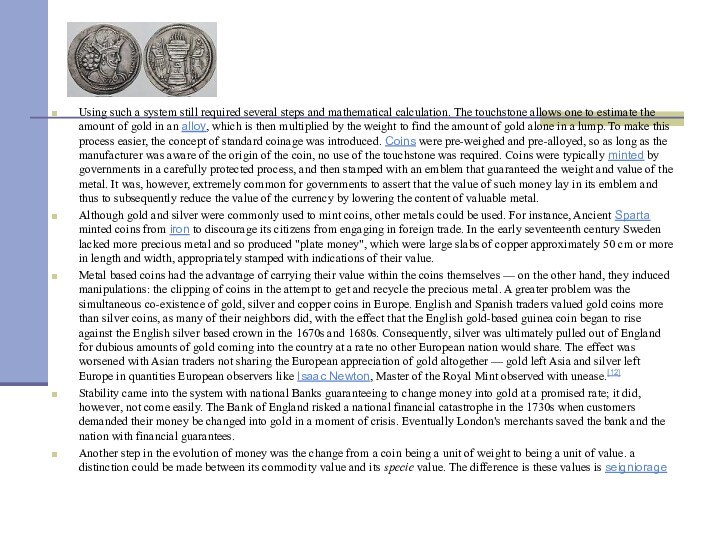


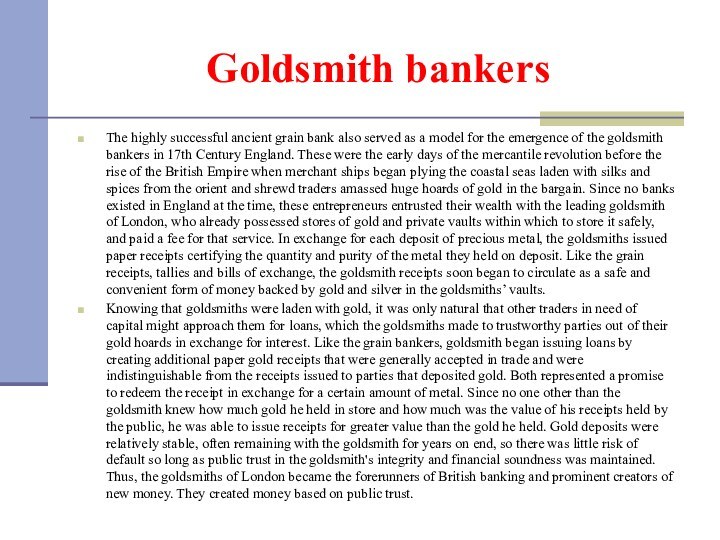
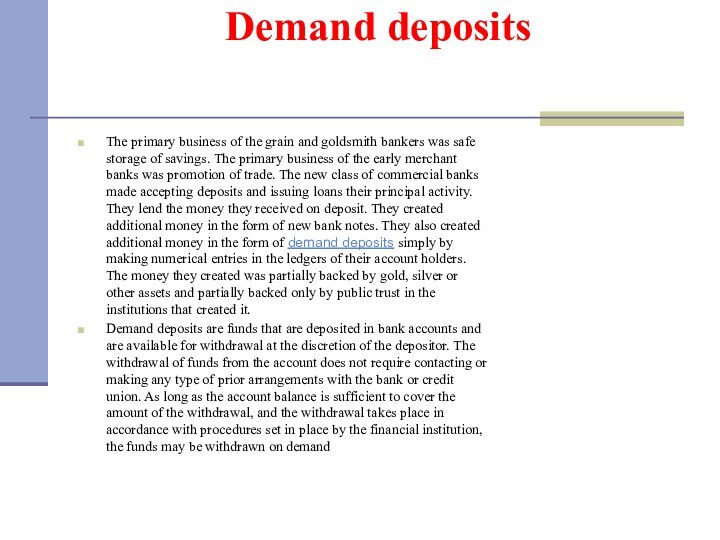
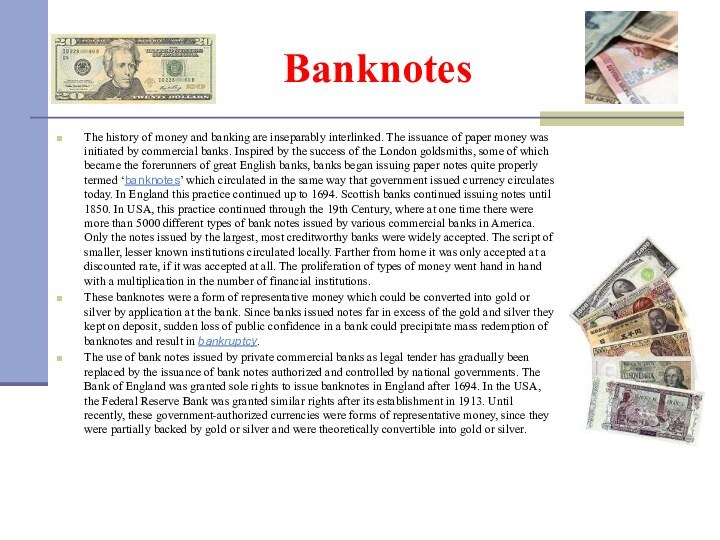
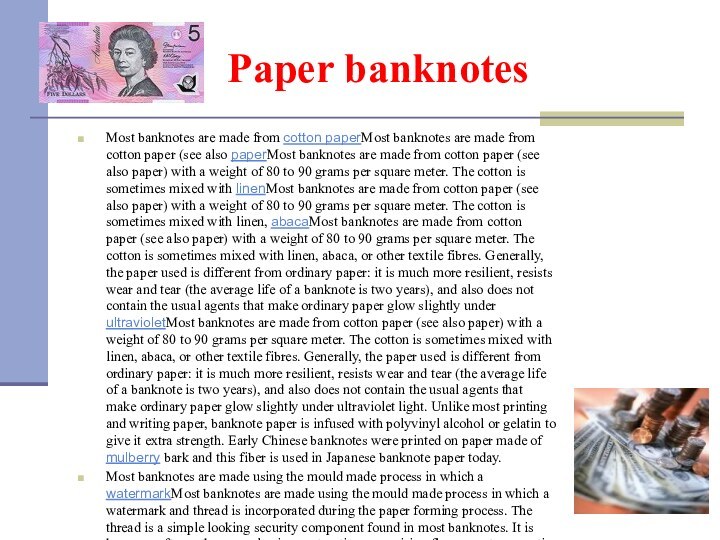
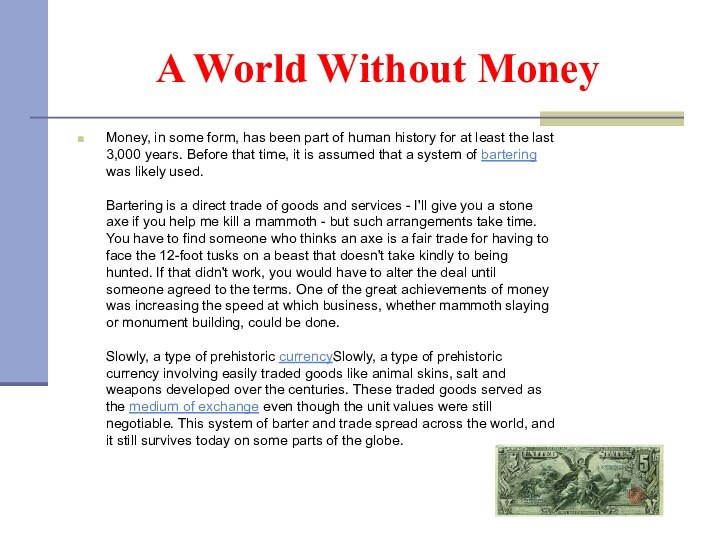
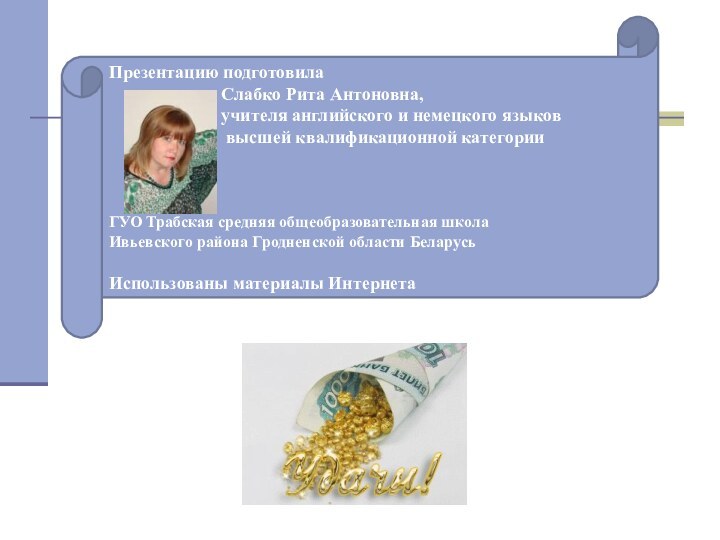
Слайд 3
The emergence of money
The SumerianThe Sumerian civilization developed
a large scale economyThe Sumerian civilization developed a large
scale economy based on commodity moneyThe Sumerian civilization developed a large scale economy based on commodity money. The BabyloniansThe Sumerian civilization developed a large scale economy based on commodity money. The Babylonians and their neighboring city statesThe Sumerian civilization developed a large scale economy based on commodity money. The Babylonians and their neighboring city states later developed the earliest system of economicsThe Sumerian civilization developed a large scale economy based on commodity money. The Babylonians and their neighboring city states later developed the earliest system of economics as we think of it today, in terms of rules on debt, legal contracts and law codes relating to business practices and private property.[5][5][6]The Code of HammurabiThe Code of Hammurabi, the best preserved ancient law codeThe Code of Hammurabi, the best preserved ancient law code, was created ca. 1760 BCThe Code of Hammurabi, the best preserved ancient law code, was created ca. 1760 BC (middle chronologyThe Code of Hammurabi, the best preserved ancient law code, was created ca. 1760 BC (middle chronology) in ancient BabylonThe Code of Hammurabi, the best preserved ancient law code, was created ca. 1760 BC (middle chronology) in ancient Babylon. It was enacted by the sixth Babylonian king, HammurabiThe Code of Hammurabi, the best preserved ancient law code, was created ca. 1760 BC (middle chronology) in ancient Babylon. It was enacted by the sixth Babylonian king, Hammurabi. Earlier collections of laws include the code of Ur-NammuThe Code of Hammurabi, the best preserved ancient law code, was created ca. 1760 BC (middle chronology) in ancient Babylon. It was enacted by the sixth Babylonian king, Hammurabi. Earlier collections of laws include the code of Ur-Nammu, king of UrThe Code of Hammurabi, the best preserved ancient law code, was created ca. 1760 BC (middle chronology) in ancient Babylon. It was enacted by the sixth Babylonian king, Hammurabi. Earlier collections of laws include the code of Ur-Nammu, king of Ur (ca. 2050 BC), the Code of EshnunnaThe Code of Hammurabi, the best preserved ancient law code, was created ca. 1760 BC (middle chronology) in ancient Babylon. It was enacted by the sixth Babylonian king, Hammurabi. Earlier collections of laws include the code of Ur-Nammu, king of Ur (ca. 2050 BC), the Code of Eshnunna (ca. 1930 BC) and the code of Lipit-IshtarThe Code of Hammurabi, the best preserved ancient law code, was created ca. 1760 BC (middle chronology) in ancient Babylon. It was enacted by the sixth Babylonian king, Hammurabi. Earlier collections of laws include the code of Ur-Nammu, king of Ur (ca. 2050 BC), the Code of Eshnunna (ca. 1930 BC) and the code of Lipit-Ishtar of Isin (ca. 1870 BC).[7] These law codes formalized the role of money in civil society. They set amounts of interest on debt... fines for 'wrong doing'... and compensation in money for various infractions of formalized law.
The ShekelThe Shekel referred to an ancient unit of weight and currency. The first usage of the term came from MesopotamiaThe Shekel referred to an ancient unit of weight and currency. The first usage of the term came from Mesopotamia circa 3000 BC. and referred to a specific mass of barleyThe Shekel referred to an ancient unit of weight and currency. The first usage of the term came from Mesopotamia circa 3000 BC. and referred to a specific mass of barley which related other values in a metricThe Shekel referred to an ancient unit of weight and currency. The first usage of the term came from Mesopotamia circa 3000 BC. and referred to a specific mass of barley which related other values in a metric such as silver, bronze, copper etc. A barley/shekel was originally both a unit of currency and a unit of weight, just as the British Pound was originally a unit denominating a one pound mass of silver.
In the absence of a medium of exchange, non-monetary societies operated largely along the principles of gift economics. When barter did in fact occur, it was usually between either complete strangers or would-be enemies.
Слайд 4
Commodity money
Bartering has several problems, most notably that
it requires a 'coincidence of wantsBartering has several problems,
most notably that it requires a 'coincidence of wants'. For example, if a wheatBartering has several problems, most notably that it requires a 'coincidence of wants'. For example, if a wheat farmer needs what a fruitBartering has several problems, most notably that it requires a 'coincidence of wants'. For example, if a wheat farmer needs what a fruit farmer producesBartering has several problems, most notably that it requires a 'coincidence of wants'. For example, if a wheat farmer needs what a fruit farmer produces, a direct swapBartering has several problems, most notably that it requires a 'coincidence of wants'. For example, if a wheat farmer needs what a fruit farmer produces, a direct swap is impossible as seasonalBartering has several problems, most notably that it requires a 'coincidence of wants'. For example, if a wheat farmer needs what a fruit farmer produces, a direct swap is impossible as seasonal fruit would spoil before the grain harvest. A solution is to tradeBartering has several problems, most notably that it requires a 'coincidence of wants'. For example, if a wheat farmer needs what a fruit farmer produces, a direct swap is impossible as seasonal fruit would spoil before the grain harvest. A solution is to trade fruit for wheat indirectly through a third, "intermediate", commodityBartering has several problems, most notably that it requires a 'coincidence of wants'. For example, if a wheat farmer needs what a fruit farmer produces, a direct swap is impossible as seasonal fruit would spoil before the grain harvest. A solution is to trade fruit for wheat indirectly through a third, "intermediate", commodity: the fruit is exchanged for the intermediate commodity when the fruit ripens. If this intermediate commodity doesn't perish doesn't perish and is reliably in demand doesn't perish and is reliably in demand throughout the year (e.g. copper doesn't perish and is reliably in demand throughout the year (e.g. copper, gold, or wine doesn't perish and is reliably in demand throughout the year (e.g. copper, gold, or wine) then it can be exchanged for wheat after the harvest doesn't perish and is reliably in demand throughout the year (e.g. copper, gold, or wine) then it can be exchanged for wheat after the harvest. The function of the intermediate commodity as a store-of-value can be standardized into a widespread commodity money doesn't perish and is reliably in demand throughout the year (e.g. copper, gold, or wine) then it can be exchanged for wheat after the harvest. The function of the intermediate commodity as a store-of-value can be standardized into a widespread commodity money, reducing the coincidence of wants problem. By overcoming the limitations of simple barter, a commodity money makes the market doesn't perish and is reliably in demand throughout the year (e.g. copper, gold, or wine) then it can be exchanged for wheat after the harvest. The function of the intermediate commodity as a store-of-value can be standardized into a widespread commodity money, reducing the coincidence of wants problem. By overcoming the limitations of simple barter, a commodity money makes the market in all other commodities more liquid.Many cultures around the world eventually developed the use of commodity money. Ancient China and Africa used cowrie shellsMany cultures around the world eventually developed the use of commodity money. Ancient China and Africa used cowrie shells. Trade in Japan's feudal system was based on the kokuMany cultures around the world eventually developed the use of commodity money. Ancient China and Africa used cowrie shells. Trade in Japan's feudal system was based on the koku - a unit of rice per year. The shekelMany cultures around the world eventually developed the use of commodity money. Ancient China and Africa used cowrie shells. Trade in Japan's feudal system was based on the koku - a unit of rice per year. The shekel was an ancient unit of weight and currency. The first usage of the term came from MesopotamiaMany cultures around the world eventually developed the use of commodity money. Ancient China and Africa used cowrie shells. Trade in Japan's feudal system was based on the koku - a unit of rice per year. The shekel was an ancient unit of weight and currency. The first usage of the term came from Mesopotamia circa 3000 BC and referred to a specific weight of barleyMany cultures around the world eventually developed the use of commodity money. Ancient China and Africa used cowrie shells. Trade in Japan's feudal system was based on the koku - a unit of rice per year. The shekel was an ancient unit of weight and currency. The first usage of the term came from Mesopotamia circa 3000 BC and referred to a specific weight of barley, which related other values in a metric such as silver, bronze, copper etc. A barley/shekel was originally both a unit of currency and a unit of weight
Слайд 5
Standardized coinage
From early times, metals, where available, have
usually been favored for use as proto-money over such
commodities as cattle, cowry shells, or salt, because they are at once durable, portable, and easily divisible. The use of gold as proto-money has been traced back to the fourth millennium B.C. when the EgyptiansFrom early times, metals, where available, have usually been favored for use as proto-money over such commodities as cattle, cowry shells, or salt, because they are at once durable, portable, and easily divisible. The use of gold as proto-money has been traced back to the fourth millennium B.C. when the Egyptians used gold bars of a set weight as a medium of exchange, as the SumeriansFrom early times, metals, where available, have usually been favored for use as proto-money over such commodities as cattle, cowry shells, or salt, because they are at once durable, portable, and easily divisible. The use of gold as proto-money has been traced back to the fourth millennium B.C. when the Egyptians used gold bars of a set weight as a medium of exchange, as the Sumerians earlier had done with silver bars. The first known ruler who officially set standards of weight and money was PheidonFrom early times, metals, where available, have usually been favored for use as proto-money over such commodities as cattle, cowry shells, or salt, because they are at once durable, portable, and easily divisible. The use of gold as proto-money has been traced back to the fourth millennium B.C. when the Egyptians used gold bars of a set weight as a medium of exchange, as the Sumerians earlier had done with silver bars. The first known ruler who officially set standards of weight and money was Pheidon. The first stamped money (having the mark of some authority in the form of a picture or words) can be seen in the Bibliothèque NationaleFrom early times, metals, where available, have usually been favored for use as proto-money over such commodities as cattle, cowry shells, or salt, because they are at once durable, portable, and easily divisible. The use of gold as proto-money has been traced back to the fourth millennium B.C. when the Egyptians used gold bars of a set weight as a medium of exchange, as the Sumerians earlier had done with silver bars. The first known ruler who officially set standards of weight and money was Pheidon. The first stamped money (having the mark of some authority in the form of a picture or words) can be seen in the Bibliothèque Nationale of Paris. It is an electrumFrom early times, metals, where available, have usually been favored for use as proto-money over such commodities as cattle, cowry shells, or salt, because they are at once durable, portable, and easily divisible. The use of gold as proto-money has been traced back to the fourth millennium B.C. when the Egyptians used gold bars of a set weight as a medium of exchange, as the Sumerians earlier had done with silver bars. The first known ruler who officially set standards of weight and money was Pheidon. The first stamped money (having the mark of some authority in the form of a picture or words) can be seen in the Bibliothèque Nationale of Paris. It is an electrum staterFrom early times, metals, where available, have usually been favored for use as proto-money over such commodities as cattle, cowry shells, or salt, because they are at once durable, portable, and easily divisible. The use of gold as proto-money has been traced back to the fourth millennium B.C. when the Egyptians used gold bars of a set weight as a medium of exchange, as the Sumerians earlier had done with silver bars. The first known ruler who officially set standards of weight and money was Pheidon. The first stamped money (having the mark of some authority in the form of a picture or words) can be seen in the Bibliothèque Nationale of Paris. It is an electrum stater of a turtleFrom early times, metals, where available, have usually been favored for use as proto-money over such commodities as cattle, cowry shells, or salt, because they are at once durable, portable, and easily divisible. The use of gold as proto-money has been traced back to the fourth millennium B.C. when the Egyptians used gold bars of a set weight as a medium of exchange, as the Sumerians earlier had done with silver bars. The first known ruler who officially set standards of weight and money was Pheidon. The first stamped money (having the mark of some authority in the form of a picture or words) can be seen in the Bibliothèque Nationale of Paris. It is an electrum stater of a turtle coin, coined at AeginaFrom early times, metals, where available, have usually been favored for use as proto-money over such commodities as cattle, cowry shells, or salt, because they are at once durable, portable, and easily divisible. The use of gold as proto-money has been traced back to the fourth millennium B.C. when the Egyptians used gold bars of a set weight as a medium of exchange, as the Sumerians earlier had done with silver bars. The first known ruler who officially set standards of weight and money was Pheidon. The first stamped money (having the mark of some authority in the form of a picture or words) can be seen in the Bibliothèque Nationale of Paris. It is an electrum stater of a turtle coin, coined at Aegina island. This remarkable coin dates about 700 B.C. Electrum coins were also introduced about 650 B.C. in Lydia.Coinage was widely adopted across IoniaCoinage was widely adopted across Ionia and mainland Greece during the 6th century B.C.Coinage was widely adopted across Ionia and mainland Greece during the 6th century B.C., eventually leading to the Athenian EmpireCoinage was widely adopted across Ionia and mainland Greece during the 6th century B.C., eventually leading to the Athenian Empire's 5th century B.C., dominance of the region through their export of silver coinageCoinage was widely adopted across Ionia and mainland Greece during the 6th century B.C., eventually leading to the Athenian Empire's 5th century B.C., dominance of the region through their export of silver coinage, mined in southern AtticaCoinage was widely adopted across Ionia and mainland Greece during the 6th century B.C., eventually leading to the Athenian Empire's 5th century B.C., dominance of the region through their export of silver coinage, mined in southern Attica at LauriumCoinage was widely adopted across Ionia and mainland Greece during the 6th century B.C., eventually leading to the Athenian Empire's 5th century B.C., dominance of the region through their export of silver coinage, mined in southern Attica at Laurium and Thorikos. A major silver vein discovery at LauriumCoinage was widely adopted across Ionia and mainland Greece during the 6th century B.C., eventually leading to the Athenian Empire's 5th century B.C., dominance of the region through their export of silver coinage, mined in southern Attica at Laurium and Thorikos. A major silver vein discovery at Laurium in 483 BCCoinage was widely adopted across Ionia and mainland Greece during the 6th century B.C., eventually leading to the Athenian Empire's 5th century B.C., dominance of the region through their export of silver coinage, mined in southern Attica at Laurium and Thorikos. A major silver vein discovery at Laurium in 483 BC led to the huge expansion of the Athenian military fleet. Competing coinage standards at the time were maintained by MytileneCoinage was widely adopted across Ionia and mainland Greece during the 6th century B.C., eventually leading to the Athenian Empire's 5th century B.C., dominance of the region through their export of silver coinage, mined in southern Attica at Laurium and Thorikos. A major silver vein discovery at Laurium in 483 BC led to the huge expansion of the Athenian military fleet. Competing coinage standards at the time were maintained by Mytilene and PhokaiaCoinage was widely adopted across Ionia and mainland Greece during the 6th century B.C., eventually leading to the Athenian Empire's 5th century B.C., dominance of the region through their export of silver coinage, mined in southern Attica at Laurium and Thorikos. A major silver vein discovery at Laurium in 483 BC led to the huge expansion of the Athenian military fleet. Competing coinage standards at the time were maintained by Mytilene and Phokaia using coins of ElectrumCoinage was widely adopted across Ionia and mainland Greece during the 6th century B.C., eventually leading to the Athenian Empire's 5th century B.C., dominance of the region through their export of silver coinage, mined in southern Attica at Laurium and Thorikos. A major silver vein discovery at Laurium in 483 BC led to the huge expansion of the Athenian military fleet. Competing coinage standards at the time were maintained by Mytilene and Phokaia using coins of Electrum; Aegina used silver.
It was the discovery of the touchstoneIt was the discovery of the touchstone which led the way for metal-based commodity money and coinage. Any soft metal can be tested for purity on a touchstone, allowing one to quickly calculate the total content of a particular metal in a lump. Gold is a soft metal, which is also hard to come by, dense, and storable. As a result, monetary gold spread very quickly from Asia Minor, where it first gained wide usage, to the entire world.
Слайд 6 Using such a system still required several steps
and mathematical calculation. The touchstone allows one to estimate
the amount of gold in an alloy, which is then multiplied by the weight to find the amount of gold alone in a lump. To make this process easier, the concept of standard coinage was introduced. Coins were pre-weighed and pre-alloyed, so as long as the manufacturer was aware of the origin of the coin, no use of the touchstone was required. Coins were typically minted by governments in a carefully protected process, and then stamped with an emblem that guaranteed the weight and value of the metal. It was, however, extremely common for governments to assert that the value of such money lay in its emblem and thus to subsequently reduce the value of the currency by lowering the content of valuable metal.Although gold and silver were commonly used to mint coins, other metals could be used. For instance, Ancient Sparta minted coins from iron to discourage its citizens from engaging in foreign trade. In the early seventeenth century Sweden lacked more precious metal and so produced "plate money", which were large slabs of copper approximately 50 cm or more in length and width, appropriately stamped with indications of their value.
Metal based coins had the advantage of carrying their value within the coins themselves — on the other hand, they induced manipulations: the clipping of coins in the attempt to get and recycle the precious metal. A greater problem was the simultaneous co-existence of gold, silver and copper coins in Europe. English and Spanish traders valued gold coins more than silver coins, as many of their neighbors did, with the effect that the English gold-based guinea coin began to rise against the English silver based crown in the 1670s and 1680s. Consequently, silver was ultimately pulled out of England for dubious amounts of gold coming into the country at a rate no other European nation would share. The effect was worsened with Asian traders not sharing the European appreciation of gold altogether — gold left Asia and silver left Europe in quantities European observers like Isaac Newton, Master of the Royal Mint observed with unease.[12]
Stability came into the system with national Banks guaranteeing to change money into gold at a promised rate; it did, however, not come easily. The Bank of England risked a national financial catastrophe in the 1730s when customers demanded their money be changed into gold in a moment of crisis. Eventually London's merchants saved the bank and the nation with financial guarantees.
Another step in the evolution of money was the change from a coin being a unit of weight to being a unit of value. a distinction could be made between its commodity value and its specie value. The difference is these values is seigniorage
Слайд 7
Trade bills of exchange
Bills of exchange became prevalent
with the expansion of European trade toward the end
of the Middle Ages. A flourishing Italian wholesale trade in cloth, woolen clothing, wine, tin and other commodities was heavily dependent on credit for its rapid expansion. Goods were supplied to a buyer against a bill of exchange, which constituted the buyer's promise to make payment at some specified future date. Provided that the buyer was reputable or the bill was endorsed by a credible guarantor, the seller could then present the bill to a merchant banker and redeem it in money at a discounted value before it actually became due.These bills could also be used as a form of payment by the seller to make additional purchases from his own suppliers. Thus, the bills – an early form of credit – became both a medium of exchange and a medium for storage of value. Like the loans made by the Egyptian grain banks, this trade credit became a significant source for the creation of new money. In England, bills of exchange became an important form of credit and money during last quarter of the 18th century and the first quarter of the 19th century before banknotes, checks and cash credit lines were widely available
Слайд 8
Tallies
The acceptance of symbolic forms of money opened
up vast new realms for human creativity. A symbol
could be used to represent something of value that was available in physical storage somewhere else in space, such as grain in the warehouse. It could also be used to represent something of value that would be available later in time, such as a promissory note or bill of exchange, a document ordering someone to pay a certain sum of money to another on a specific date or when certain conditions have been fulfilled.In the 12th Century, the English monarchy introduced an early version of the bill of exchange in the form of a notched piece of wood known as a tally stick. Tallies originally came into use at a time when paper was rare and costly, but their use persisted until the early 19th Century, even after paper forms of money had become prevalent. The notches were used to denote various amounts of taxes payable to the crown. Initially tallies were simply used as a form of receipt to the tax payer at the time of rendering his dues. As the revenue department became more efficient, they began issuing tallies to denote a promise of the tax assessee to make future tax payments at specified times during the year. Each tally consisted of a matching pair – one stick was given to the assessee at the time of assessment representing the amount of taxes to be paid later and the other held by the Treasury representing the amount of taxes be collected at a future date.
The Treasury discovered that these tallies could also be used to create money. When the crown had exhausted its current resources, it could use the tally receipts representing future tax payments due to the crown as a form of payment to its own creditors, who in turn could either collect the tax revenue directly from those assessed or use the same tally to pay their own taxes to the government. The tallies could also be sold to other parties in exchange for gold or silver coin at a discount reflecting the length of time remaining until the taxes was due for payment. Thus, the tallies became an accepted medium of exchange for some types of transactions and an accepted medium for store of value. Like the girobanks before it, the Treasury soon realized that it could also issue tallies that were not backed by any specific assessment of taxes. By doing so, the Treasury created new money that was backed by public trust and confidence in the monarchy rather than by specific revenue receipts
Слайд 9
Goldsmith bankers
The highly successful ancient grain bank also
served as a model for the emergence of the
goldsmith bankers in 17th Century England. These were the early days of the mercantile revolution before the rise of the British Empire when merchant ships began plying the coastal seas laden with silks and spices from the orient and shrewd traders amassed huge hoards of gold in the bargain. Since no banks existed in England at the time, these entrepreneurs entrusted their wealth with the leading goldsmith of London, who already possessed stores of gold and private vaults within which to store it safely, and paid a fee for that service. In exchange for each deposit of precious metal, the goldsmiths issued paper receipts certifying the quantity and purity of the metal they held on deposit. Like the grain receipts, tallies and bills of exchange, the goldsmith receipts soon began to circulate as a safe and convenient form of money backed by gold and silver in the goldsmiths’ vaults.Knowing that goldsmiths were laden with gold, it was only natural that other traders in need of capital might approach them for loans, which the goldsmiths made to trustworthy parties out of their gold hoards in exchange for interest. Like the grain bankers, goldsmith began issuing loans by creating additional paper gold receipts that were generally accepted in trade and were indistinguishable from the receipts issued to parties that deposited gold. Both represented a promise to redeem the receipt in exchange for a certain amount of metal. Since no one other than the goldsmith knew how much gold he held in store and how much was the value of his receipts held by the public, he was able to issue receipts for greater value than the gold he held. Gold deposits were relatively stable, often remaining with the goldsmith for years on end, so there was little risk of default so long as public trust in the goldsmith's integrity and financial soundness was maintained. Thus, the goldsmiths of London became the forerunners of British banking and prominent creators of new money. They created money based on public trust.
Слайд 10
Demand deposits
The primary business of the grain and
goldsmith bankers was safe storage of savings. The primary
business of the early merchant banks was promotion of trade. The new class of commercial banks made accepting deposits and issuing loans their principal activity. They lend the money they received on deposit. They created additional money in the form of new bank notes. They also created additional money in the form of demand deposits simply by making numerical entries in the ledgers of their account holders. The money they created was partially backed by gold, silver or other assets and partially backed only by public trust in the institutions that created it.Demand deposits are funds that are deposited in bank accounts and are available for withdrawal at the discretion of the depositor. The withdrawal of funds from the account does not require contacting or making any type of prior arrangements with the bank or credit union. As long as the account balance is sufficient to cover the amount of the withdrawal, and the withdrawal takes place in accordance with procedures set in place by the financial institution, the funds may be withdrawn on demand
Слайд 11
Banknotes
The history of money and banking are inseparably
interlinked. The issuance of paper money was initiated by
commercial banks. Inspired by the success of the London goldsmiths, some of which became the forerunners of great English banks, banks began issuing paper notes quite properly termed ‘banknotes’ which circulated in the same way that government issued currency circulates today. In England this practice continued up to 1694. Scottish banks continued issuing notes until 1850. In USA, this practice continued through the 19th Century, where at one time there were more than 5000 different types of bank notes issued by various commercial banks in America. Only the notes issued by the largest, most creditworthy banks were widely accepted. The script of smaller, lesser known institutions circulated locally. Farther from home it was only accepted at a discounted rate, if it was accepted at all. The proliferation of types of money went hand in hand with a multiplication in the number of financial institutions.These banknotes were a form of representative money which could be converted into gold or silver by application at the bank. Since banks issued notes far in excess of the gold and silver they kept on deposit, sudden loss of public confidence in a bank could precipitate mass redemption of banknotes and result in bankruptcy.
The use of bank notes issued by private commercial banks as legal tender has gradually been replaced by the issuance of bank notes authorized and controlled by national governments. The Bank of England was granted sole rights to issue banknotes in England after 1694. In the USA, the Federal Reserve Bank was granted similar rights after its establishment in 1913. Until recently, these government-authorized currencies were forms of representative money, since they were partially backed by gold or silver and were theoretically convertible into gold or silver.
Слайд 12
Paper banknotes
Most banknotes are made from cotton paperMost
banknotes are made from cotton paper (see also paperMost
banknotes are made from cotton paper (see also paper) with a weight of 80 to 90 grams per square meter. The cotton is sometimes mixed with linenMost banknotes are made from cotton paper (see also paper) with a weight of 80 to 90 grams per square meter. The cotton is sometimes mixed with linen, abacaMost banknotes are made from cotton paper (see also paper) with a weight of 80 to 90 grams per square meter. The cotton is sometimes mixed with linen, abaca, or other textile fibres. Generally, the paper used is different from ordinary paper: it is much more resilient, resists wear and tear (the average life of a banknote is two years), and also does not contain the usual agents that make ordinary paper glow slightly under ultravioletMost banknotes are made from cotton paper (see also paper) with a weight of 80 to 90 grams per square meter. The cotton is sometimes mixed with linen, abaca, or other textile fibres. Generally, the paper used is different from ordinary paper: it is much more resilient, resists wear and tear (the average life of a banknote is two years), and also does not contain the usual agents that make ordinary paper glow slightly under ultraviolet light. Unlike most printing and writing paper, banknote paper is infused with polyvinyl alcohol or gelatin to give it extra strength. Early Chinese banknotes were printed on paper made of mulberry bark and this fiber is used in Japanese banknote paper today.Most banknotes are made using the mould made process in which a watermarkMost banknotes are made using the mould made process in which a watermark and thread is incorporated during the paper forming process. The thread is a simple looking security component found in most banknotes. It is however often rather complex in construction comprising fluorescent, magnetic, metallic and micro print elements. By combining it with watermarking technology the thread can be made to surface periodically on one side only. This is known as windowed thread and further increases the counterfeit resistance of the banknote paper. This process was invented by Portals, part of the De La Rue group in the UK. Other related methods include watermarking to reduce the number of corner folds by strengthening this part of the note, coatings to reduce the accumulation of dirt on the note, and plastic windows in the paper that make it very hard to copy





